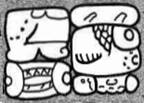




K&L.p12.#3 TOK.p30.r2.c1 BMM9.p19.r1.c2 MHD.BXC.1&2 1532st
OX / O’X OOX OX KOX? -


![]()
Safronov Mathews Lacadena
CRN Panel 1 P4 CRN Panel D D1 EKB Column 1 Text 2 ‘A3’
<OX:xa>.<<lu[ku]>:a> <*OX?:*xa?>.<<*lu?[*ku?]>:*a?> K’AHK’.OX.xa



González-EAFeePCTM.p305.pdfp316.fig4.70 (Martin) Schele HrubyEtAl-AICV
MSK844 K (a.k.a. CLK Tomb 4 Plate) PAL House C HS C1 Ucí Incised Ceramic Vessel B2
<OX:xa>.<<lu+ku>:a> <k’o?:xo>.<<lu+ku>:a> <KOOX:ko>.<xa:<lu+ku>:a>
· No glyphs given in K&H, 25EMC.
· Note that MSK844 is not the “Kerr vase” K844 (such a Kerr vase doesn’t exist).
· Pronunciation:
o K’ox Luka. Prager-ÜAidKMR.p252.pdfp266.#18 (2013) reads this as k’ox luka. [Sim: Indeed the first glyph in PAL House C HS C1 does look like a k’o.]
o O’x. K&L.p12.pdfp12.#3 (2018): Possible rebus for o’x ‘fierce’.
o O’x Luka. González-EAFeePCTM (2018) lists four inscriptions where O’x Luka occurs:
§ González-EAFeePCTM.p253.pdfp264.fig4.13: CRN Panel 1 P4.
§ González-EAFeePCTM.p252.pdfp263.fig4.12: CRN Panel D D1.
§ González-EAFeePCTM.p304.pdfp315.fig4.69 & González-EAFeePCTM.p305.pdfp316.fig4.70: MSK844 K a.k.a. CLK Structure 2B-sub Tomb Ceramic Vessel a.k.a. CLK Tomb 4 Plate and other variations.
§ González-EAFeePCTM.p305.pdfp316.fig4.70: PAL HCHS C1.
o Koox Kula’. HrubyEtAl-AICV.p159.pdfp7.c2.para2 (2022): An additional title for the individual is written at B2 (Fig. 9b), and is familiar from a number of other examples, several associated with the Calakmul and La Corona regions (Fig. 10). Its meaning remains obscure. In most cases this glyph consists of an upright bird's wing followed by the conflated form of ku-lu, suffixed then by -a. Here on the Ucí vase we find two additional signs, ko and xa, between the wing and the ku-lu. Surely, this relates to examples where we find xa or xo alone as suffixes to the bird's wing. The ko-xa sequence at Ucí suggests the possibility that the wing stands as a logogram for KOOX, corresponding to the bird name koox. This has various meanings in lowland Mayan languages, including "faisán" or "nocturnal hawk" in Yukatek (Bricker, Po'ot Yah and Dzul de Po'ot 1998: 134), "crested guan" in Itzaj (Hofling 1997: 361) or "pheasant" or "pava" in Ch'ol (Aulie and Aulie 1978: 39, Whittaker and Warkentin 1965: 161). In Ch'orti, koxkox is "pygmy owl" (Hull 2016: 207). However we interpret the specific species, it seems that the Ucí vase may provide an important new clue to the full reading of the initial sign as KOOX, reinforced by the complementary sequence ko and xa (a very rare case of a redundant spelling via both a logogram and a syllabic grouping). The full reading of the title may be koox kula', semantically obscure yet important as a royal title in several Maya courts. It is known from only one other example from Yucatan, on an inscribed column from Ek Balam. [Sim: Other epigraphers have read the ku-lu-a as Luka, but HrubyEtAl-AICV reads it as Kula’ – not only is the reading order of the conflated ku and lu syllabograms switched, but there is also a final glottal stop read.]
· Sim: The arguments of HrubyEtAl-AICV are good, but I’m slightly reluctant to fully adopt KOOX and declare O’X fully superseded. This is because the two syllabograms follow one another, and come after the logogram: KOOX-ko-xa. I feel that ko-KOOX-xa would have been slightly more reassuring, as that would have made the two syllabograms into initial and final phonetic complements. In the current situation, it’s more a “respelling” of the logogram, and hence writes koox “a second time”, after the logogram itself. It would be good to compare this with the few other instances where a (say) disyllabic morpheme is written with a logogram and three syllabograms, to see what the relative positioning is. MHD is partly convinced, as it gives KOX?. Bonn isn’t, and leaves it without even an uncertain reading.
· The identity of this glyph:
o Because of the three “bumps” along the bottom (and optionally a small, darkened circle inside each “bump”), KOOX might be confused with the variant of ICH’AAK with retracted claws (the darkened circles being mistaken for paw pads). However, it is unrelated to ICH’AAK and actually represents a bird-wing – HrubyEtAl-AICV.p159.pdfp7.c2.para2.l+4: In most cases this glyph consists of an upright bird's wing […].
o [Sim:] KOOX/O’X – as shown in PAL House C HS C1 and Ucí Incised Ceramic Vessel B2 – doesn’t particularly resemble other more “canonical” examples, both from real-life and from teaching resources. However, their co-occurrence with the <ku+lu>:a in MSK844 K (which does have a canonical example) is sufficient for us to make this identification.
· With the old reading OX, it might have been confused with the phonetically similar UHX = “3” (formerly read as OX/O’X). This potential confusion is not present with the reading KOOX.
· Usage:
o In CRN Panel 1, CRN Panel D, and MSK844 (a.k.a. CLK Structure II-B Tomb 4 Plate), O’x Luka / Koox Kula’ is an additional name/title for Yuknoom Yich’aak K’ahk’, a famous ruler of CLK. The two CRN Panels each speak about him fleeing with his younger brother, the Utz’eh K’ab K’inich. The inscription on MSK844 only speaks about it being his plate.
o In PAL House C HS C1 it’s an additional name/title of “Sky Witness”, a ruler of CLK – named on a PAL monument because he once attacked PAL. This is a different individual from Yuknoom Yich’aak K’ahk’.
o I haven’t yet been able to determine the identity of the individual(s) referred to in EKB Column 1 Text 2 ‘A3’ and the Ucí Incised Ceramic Vessel B2.